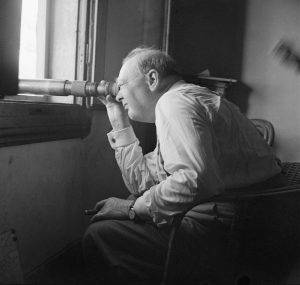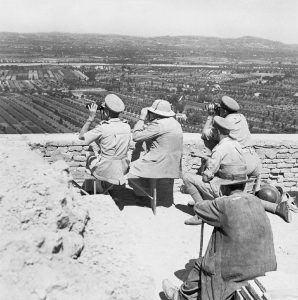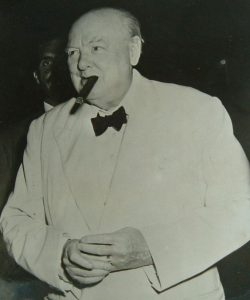
Finest Hour 173
In the Land of Caesars: Churchill and Italy
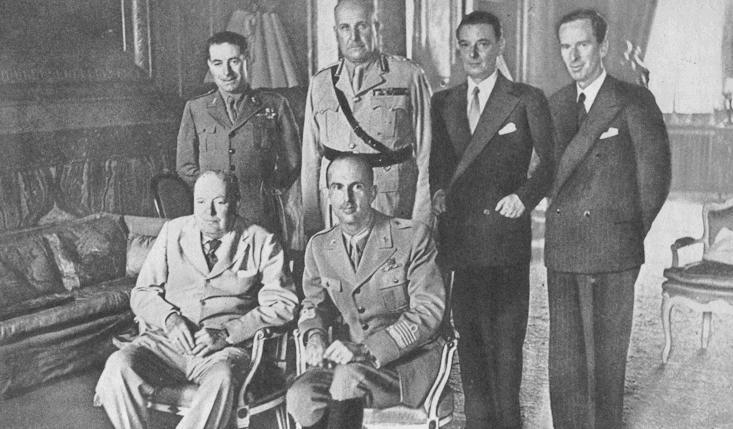
August 14, 2016
Finest Hour 173, Summer 2016
Page 16
By Patrizio Romano Giangreco and Andrew Martin Garvey
Patrizio Romano Giangreco lives in Italy. He is grateful to Andrew Martin Garvey of the University of Turin and Italian Officers College for assistance in preparing this article.
At age nineteen Winston Churchill first set foot in Italy in August 1893. He had passed into Italy via Switzerland, where he had gone as a reward for having passed the entrance exams to the Royal Military College, Sandhurst.

2024 International Churchill Conference
He was favorably impressed by the activity of the Milanese and even more so by the female company he kept. While staying in Milan he took boat trips, one of which was on Lake Maggiore to admire the extraordinary beauty of the Borromeo Islands and their lovely gardens: beauties he described in glowing terms in his letters home to his mother.
Mussolini Encounters
Some thirty-four years were to go by before Churchill returned to Italy in January 1927. By then he was Chancellor of the Exchequer in the Baldwin Government and had organized a trip to Europe with his wife Clementine and their children Randolph and Sarah. In Rome, Churchill, a guest of the British Ambassador in Italy, was enchanted by the Forum and, finding time to devote himself to his favorite hobby, did not fail to portray it in some paintings he executed on the spot.
During his 1927 stay, Churchill met Mussolini, then the undisputed leader of Fascist Italy. The two men exchanged visits at Palazzo Chigi, the seat of the Italian government, and the British Embassy. These were not their first meetings: their paths had previously crossed at the Locarno conference in 1925. In those years there were still good relations between the United Kingdom and Italy. Churchill expressed feelings of admiration towards the country and to Il Duce, both for his political action and as a person, views he clearly stated during a conference with the Italian press.
Churchill’s respect for Mussolini at this time was shared by most of the British political world and largely based on authentic fear of the spread of communism to Western Europe. In those years, in which the comet Hitler had yet to arise, Italy and its Duce, whose fascist regime—dictatorial though it was—had not reached the excesses of the 1930s or complete subservience to the Nazis, were seen as a mighty bastion against this danger. This British admiration for part of the Fascist model was, however, short-lived. Dissension followed Italy’s 1936 conquest of Ethiopia, which seemed to encroach on the specific interests of the British Empire and irreversibly spoiled the hitherto cordial relations between Churchill and Mussolini.
Churchill, then in his “wilderness years” and out of office, made efforts to stop Italy becoming embroiled in a colonial war, to the extent that he even used his personal friendship with Dino Grandi, then the Italian Ambassador to the Court of St. James’s and the future liquidator of the Fascist regime. An atypical Italian and Anglophile, Grandi had developed close friendships with members of the British establishment, but these relationships were not appreciated in Rome and led to his being recalled to Italy and appointed as Minister of Justice in order to isolate him from his English friends. Grandi’s friendship with Churchill, however, was to last for the rest of the Great Man’s life. At the time of Churchill’s funeral, Grandi published an article in the Italian magazine Epoca expressing his gratitude for the help Churchill provided that enabled Grandi and his family to flee Nazi-Fascist revenge and safely to reach Portugal in 1943, following Mussolini’s removal from office.
The War Years
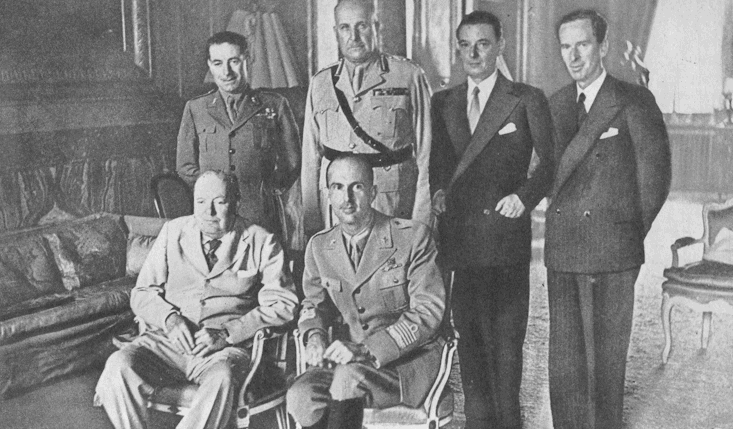
After the war began and Churchill became prime minister, one of his first official acts, at the suggestion of Lord Halifax, was to appeal to Mussolini not to enter the war. Churchill wrote on 16 May 1940. His letter was full of pathos and recalled their previous meetings, words of peace, and good will expressed. Churchill invited Il Duce to consider that it was not “too late to stop a river of blood from flowing between the British and Italian peoples.”1
Mussolini replied with words of rancor about the sanctions imposed upon an Italy that only sought “a place in the sun.” Il Duce also stated that he had no intention of betraying the “Pact of Steel” with Hitler’s Germany.
These are the only letters Churchill and Mussolini ever exchanged, and the originals are now held in the their respective national archives. Of any other mysterious correspondence on which countless books and articles have been written, and on which several conjectures about their authenticity have been made, there is no trace whatsoever.2
Soon afterwards, Italy joined the war against the Allies, leading to a direct clash between the prime minister and the dictator. Mussolini never wasted an opportunity to attack and mock Churchill, even at a personal level. Likewise, Churchill pointed in his speeches to Mussolini as the only person responsible for dragging the Italian people into useless slaughter.
After Mussolini’s fall from power in July 1943 and the armistice with Italy of 8 September, Churchill dropped his stance of dislike and contempt for Italy that had characterized relations between the two countries throughout the conflict. He attributed to Italy relatively lower responsibility than that of Germany in having caused the catastrophe of war in Europe, and his aversion for Mussolini was less visceral than his loathing of Hitler. Churchill was also upset when he learned that Mussolini had been executed at the end of the war.
Epic Journey
Churchill often showed a physical attraction to danger. There was no way he could not be present on the front when he travelled to Italy during a crucial period in 1944. His stay lasted seventeen days, a period when he was constantly on the move and demonstrating a vitality and truly prodigious stamina for a man of his age and health.
On 11 August 1944 Churchill landed at Naples, accompanied by his staff, including the ubiquitous physician, Charles Wilson (later Lord Moran), his ADC Commander Charles “Tommy” Thompson, his private secretary Leslie Rowan, and the assistant private secretary John Peck. The diary of those days is impressive and can be relived chronologically:
11 August: Arrived in Naples and stayed at the Villa Rivalta on the shore of the splendid hill of Posillipo, guest of General Sir Henry Maitland “Jumbo” Wilson, Supreme Allied Commander Mediterranean.
12 August: At Caserta (Wilson’s HQ) he met Tito, leader of the Yugoslav resistance movement.
13 August: Visited the islands of Ischia and Capri, where he relaxed, swimming and sightseeing.
14 August: Flight to Corsica in a C-47 Dakota with Gen. Wilson.
15 August: Embarked on the destroyer HMS Kimberly to observe the Allied landings on coast of the South of France (Operation ANVIL/DRAGOON).
16 August: Returned to Naples.
17 August: Departure for Cassino, where he met Gen. Sir Harold Alexander, commander of the XV Allied Army Group. Survey of the battlefields and a flight over Montecassino Abbey, after which he flew in General Alexander’s plane to Siena. He stayed at Villa Placidi, near Vignano, just outside Siena, where he spent two days working.
19 August: Flew to the Adriatic front and later met General Mark Clark, commander of the US Fifth Army, in Marina di Cecina. Churchill met RAF personnel. He later went to Castiglioncello to tour the front with General Clark. In the evening he dined with Generals Clark and Alexander in Cecina. At the end of a tiring day he flew back to Siena.
21 August: Flight to Rome with his staff in Gen. Alexander’s Dakota. He stayed at the British Embassy, where he met his son Randolph, Harold Macmillan (then Minister Resident in the Mediterranean), General Sir Alan Brooke, and Marshal of the Royal Air Force Sir Charles Portal.
22 August: Met Ivanoe Bonomi, the new head of the Italian government, and Marshal Pietro Badoglio, and Prince Humbert, Lieutenant General (or Regent) of the Kingdom of Italy; of the latter Churchill felt a sense of determination and assurance.
23 August: Met Pope Pius XII (Eugenio Pacelli) in the Vatican. While the papal audience had all the pomp and ceremony of the papal court, the meeting with the Pope took place in an atmosphere of great, almost intimate, cordiality. The Pope and the Prime Minister had first met when the then-Monsignor Pacelli was with the Pontifical delegation representing Pope Pius X at the coronation of King George V in 1911. Pius XII, who was not given to great sentimental outbursts, expressed his deep admiration for Churchill’s personal qualities, while Churchill hailed Pacelli as the greatest man of his time. Returned to Siena in the evening.
25 August: Alexander took him to the Adriatic front, where the British Eighth Army was operating under the command of General Oliver Leese.
26 August: At Loreto, where he met Polish General Wadislaw Anders, Churchill was right in the firing line from which Alexander launched a major attack against the Germans. Certain it would make Churchill happy, the general took him up to an observation point over the village of Montemaggiore, where he could follow the phases of the operation. At the end of the day he went to Jesi airport in the Marches to fly back to Naples and Villa Rivalta, where he met Clement Attlee and the US Secretary of State Cordell Hull.
27 August: Rear Admiral John A. V. Morse accompanied Churchill to Procida, the third charming island in the Bay of Naples.
28 August: Wrote a message of encouragement to the Italians, in which he expressed his feeling for the warm, friendly welcome he received wherever he went and recognized that they had regretfully fallen under fascist dictatorship. He stated that the British people were willing to help Italy return to the fold of free and peaceful nations. In the afternoon he left Naples to return to London.
The next time Churchill set foot in Italy was in October of the same year, when he visited Moscow and made a stop in Rome on his outbound flight and in Naples on his return. On the latter occasion he met the communist leader Palmiro Togliatti.
Churchill saw Italy as having a leading strategic and political role in thwarting Soviet expansionism in the West and had confidence that the Italian monarchy would be a factor of stabilization and political aggregation to ward off a communist revolution, the danger of which was very real and strongly felt in the period immediately following the end of the war. In this context, Churchill supported the Badoglio Government, and, as he stated after meeting him in Rome, he had confidence in and a good opinion of Prince Humbert, who was still waiting to succeed his father King Victor Emmanuel III, then stubbornly refusing to abdicate. It was in such a context that Churchill reviewed his position on the unconditional surrender of Italy and agreed to consider Italy, in the last years of the war, as a co-belligerent country.
Post War
No longer prime minister, Churchill returned to Italy just over a year after his long visit to the Italian front. He arrived on 1 September 1945 in the Dakota made available to him by Sir Harold Alexander, who was his considerate host during his holiday. Churchill landed at Milan airport and headed towards Lake Como, where he stayed in Moltrasio until 19 September at Villa delle Rose, owned by Italian industrialist Guido Donegani.
In addition to the ever-present Lord Moran and butler Frank Sawyers, who had followed Churchill wherever he went over the course of the war, and secretary Kathleen Hill, Churchill was accompanied by his daughter Sarah and kept in touch with Clementine, who had stayed behind in London making arrangements for the Churchills’ new residence at 28 Hyde Park Gate.
Churchill dedicated his time to rest, good food, and his favorite hobby, painting, competing with Alexander, also a skilled painter, in portraying the charming lakeside villages. His daily trips were exclusively dedicated to searches for landscapes to portray on canvas. However, this stay near places that had seen the final defeat of Mussolini’s ephemeral Social Republic, so soon after the conclusion of the most catastrophic conflict that had struck Europe and the world, was immediately seen by the press, and others interested in fueling another Churchill legend, as a cover for one of Churchill’s alleged attempts to recover the phantom “correspondence” with Mussolini.
At the end of his stay on Lake Como, Churchill motored down to the eastern side of the Italian Riviera at Recco, where he stayed for a couple of days and then drove across to Monte Carlo.
Some four years later, on 25 July 1949, Churchill returned to another Italian lake, Lake Garda, and again the lake scenery was a valuable source of inspiration for his paintings. This time he was accompanied by his wife Clementine and attended by General Lord “Pug” Ismay and William “Bill” Deakin, his valued literary assistant in compiling his war memoirs.
In 1951, on the eve of his return to the leadership of His Majesty’s Government, Churchill took a short break in Venice. Churchill had further brief stays in Italy from time to time, when he was a frequent guest of Greek ship-owner Aristotle Onassis on his luxurious yacht Christina, something that gave Churchill immense pleasure in the last years of his life.
Arrivederci
In The Churchillians, Sir John Colville, one of Churchill’s most trusted secretaries, gives us one last funny anecdote about a fleeting visit across the border into Italy. In September 1954 Churchill was on the French Riviera, in Cap d’Ail, as a guest of his friend Lord Beaverbrook. Knowing Churchill’s passion for shellfish, Beaverbrook recommended a restaurant in nearby San Remo, where they served wonderful lobster.
One evening Churchill suggested a drive along the coast to San Remo with Colville and his wife Margaret. The trip was not exactly pleasant; the car was small with a blocked open window, and shortly after they had set out for San Remo a storm blew up. Once the party got to their destination with their Italian police escort, which had taken over from the French police at the frontier, they could not find the famous restaurant and had to fall back on a modest “trattoria,” where they sat down to a dinner of spaghetti and Chianti, decidedly not a wine suitable for Sir Winston’s refined palate. At that time, Italian wines had yet to reach his level of elegance. Had the Great Man been familiar with today’s Italian wines, he would certainly have welcomed them at his table and recognized yet another quality in a friendly country, as he always considered Italy to be.
Endnotes
1. Churchill to Mussolini, 16 May 1940, Churchill papers 20/14, Churchill Archives Centre, Cambridge.
2. For the full story of the correspondence that never was, see FH 149 and 168.
Subscribe
WANT MORE?
Get the Churchill Bulletin delivered to your inbox once a month.
